by scott.gillum | May 11, 2015 | 2015, Marketing
Look at the tweet, then read the graphic. Why is the headline on this tweet by Spencer Stuart, “Majority of marketing leaders want to see data-and analysis driven decision marketing on their teams,” and not “Majority of marketing leaders want to see more creative thinking and exploration on their teams?”
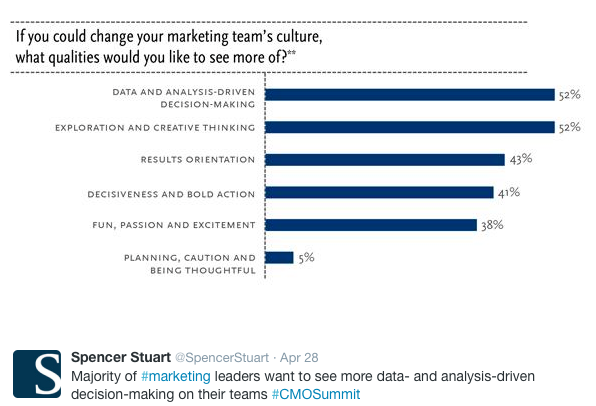
Statistically they’re the same, yet Spencer Stuart emphasized the data/analytic decision making why? “Combine Fun, Passion and Excitement” with “Decision and Bold Action” and you have a solid argument for changing the marketing team’s culture to “Exploration and Creative Thinking.”
On the flip side, only 5% of marketing wants a culture of “Planning, Caution and Being Thoughtful,” amen brother. Ok, I hear you, “if it was “fun” they would call it “play” not work, but maybe we need a little more play at work.
According to Peter Gray, a professor at Boston College and author of Free to Learn, ”play” can be the key that unlocks the mindset of bold creative thinking. In an article on Psychology Today, Gray says that the “alert but unstressed condition” of a playful mind has been shown repeatedly, in psychological experiments, to be ideal for creativity and learning new skills.
“Experiments have shown that strong pressure to perform well (which induces a non-playful state) improves performance on tasks that are mentally easy or habitual for the person, but worsens performance on tasks that require creativity, or conscious decision making, or the learning of new skills.” Although accountants may perform well under pressure, it could be a creativity killer for marketers.
One could conclude then, if an organization too narrowly focuses on “analysis and data driven decision making,” it may come at the expense of “Exploration and Creative Thinking” mentioned in the research and Tweet. Said differently, all work and no play, could make your marketers dull.
Pressure to perform in business marketing is a given, so how do you strike a healthy balance? Stephanie Anderson, CMO of Time Warner Cable’s business division, suggested that by ” focusing on business results first, ensuring that you have a way to show the business impact of marketing activities, you’ll have the foundation in place in order to inject a fun and creativity into the workplace.”
by scott.gillum | Mar 30, 2015 | 2015, Tech Trends
Last week I had the opportunity to attend two conferences that spanned the horizon of marketing. I went from “hoodies” at SXSW to “blue blazers” at the Institute for the Study of Business Markets (ISBM) Winter Member Meeting

Attendees at SXSW Interactive were young digital marketers, at the early stage of their careers. The ISBM crowd was comprised of mostly senior-level executives with 20 to 30 years of experience working for established companies.
Below are some insights from both of the events:
- Marketing is a tech wonderland. I had the chance to wander the event floor at SXSW, marvel at all of the new technologies, play with new apps, as well as attend a couple ofsessions by new tech vendors. The theme of the ISBM event was Analytics & Analysis, and I got more than my fair share of data analytics, business intelligence, econometric modeling … you name it. If you still think that half of your marketing budget is wasting away, but you don’t know which half, you’re behind the times.
- Analytics and dashboards are foundational. I saw a great presentation by Dell, which showed how the company has now mapped buyers across the buying process, complete with understanding their needs, time spent at each stage and how to optimize the experience. Likewise, Wesco and Teradata shared a wonderful journey of how Wesco put into place the tools needed to become a data-driven marketing group, enabling the company to tie its activities to business outcomes, or in this case, revenue. From what I heard and saw, companies have built the foundation to pull, analyze and report marketing performance data. Some have even made the leap into forecasting and predictive modeling.
- Investment is still a challenge. A thread ran through the ISBM event concerning the challenge of securing the funding to buy new marketing tools and/or staffing teams. Despite several speakers presenting solid case studies with clear ROIs, they were still challenged with getting the support and funding needed to continue making progress.
After having time to digest the week’s sessions, I still had a few lingering questions in my mind concerning what I heard and saw. For example:
- Is there a lack of organizational acceptance and/or appreciation of marketing insight and activities? The question that popped into my head regarding the funding challenge was, “Are marketers able to make the business case in a way that makes executives want to fund their request?” The other issue was marketing’s ability to communicate effectively across the organization based on it
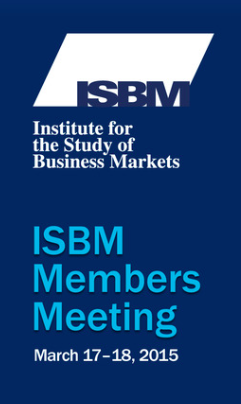 s culture. One speaker, Bill Rozier from Ciena, provided insight into how to do it effectively. Bill created a lead generation report in an easy to understand PowerPoint slide. As Bill said, “The sales team has to be able to get all the information they need in 30 seconds or less, or we’ve lost them.” Since Bill’s new report launched less than two months ago, lead reconciliation rates have gone from 13 percent to over 70 percent.
s culture. One speaker, Bill Rozier from Ciena, provided insight into how to do it effectively. Bill created a lead generation report in an easy to understand PowerPoint slide. As Bill said, “The sales team has to be able to get all the information they need in 30 seconds or less, or we’ve lost them.” Since Bill’s new report launched less than two months ago, lead reconciliation rates have gone from 13 percent to over 70 percent.
- Is there, or will there be, a communication gap between the “Hoodies” and “Blue Blazers”? It’s not necessarily a generational one, although there is that. Rather, it’s one based on what they view to be important and valuable. I saw some great social media tools at SXSW that provided deep insights into audience engagement and buyer intent. But close to half the marketing executives at the ISBM meeting had revenue targets, and almost all had lead targets. It made me think that there may be, or may soon be, a potential communication issue between the digital-savvy “engagement and intent” crowd and the “lead and revenue” veterans. From what I saw, there is still work to be done to close the gap between social media results and the connection to key performance metrics valued by marketing executives.
- Will marketing overplay analytics? Perhaps my biggest concern reflecting on the week is twofold. In business-to-business companies with strong product (and engineering) cultures that are empirically driven, will the utilization and reliance on new marketing tools and data limit an organization’s creativity, and/or innovation? The second concern has to do with organizations where marketing feels like they are under attack. Will marketers use their new reporting capabilities as a defense mechanism, hiding behind the data, instead of using it proactively to provide the organization with new insights and opportunities?
Despite these and other questions still weighing heavily on my mind, I did reach two solid conclusions. The first, Austin is by far the best food-truck town in the United States, and the second is that Tampa’s weather is the salve for the burn of the harsh Northeast winter — a point brought home to me as I returned from Tampa just in time for our first-day-of-spring snowstorm.
by scott.gillum | Mar 2, 2015 | 2015, Marketing
For business, this is turning out to be the “year of the human.” Andy Goldberg, global creative director at GE, said in an interview with Advertising Age about marketing trends in 2015: “We need B-to-B to be more human.” Karen Walkers, SVP of marketing at Cisco, went ever further by saying, “Devotion to brands begins and ends with an emotional connection. Buyers are people, people are humans and humans are emotional beings.”
Why this sudden awakening of humanity in tech marketing? The recognition that business decision makers are also people with emotional needs? Well, the answer might surprise you, and it’s based on a good bit of data and research.
The CEB (formerly Corporate Executive Board) first picked up on this trend in their research that found communicating business value (functional benefits of a product or service) was not differentiating because perceptions on that value h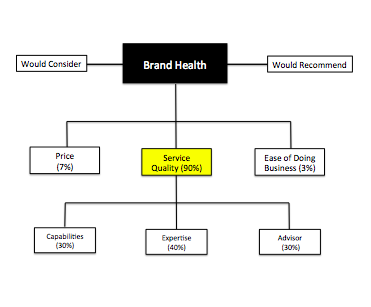 ardly varied between brands.
ardly varied between brands.
For example, a recent brand health study for a tech client found that 90 percent of their brand health (defined by a willingness to recommend and consider) was driven by service quality. Service quality made up 90 percent of the attributes in the graphic.
The smart marketer would think that in order to improve our brand health, we should increase our focus and communication for the performance attributes related to service quality. And they would be right, except for the fact that those business value drivers also apply to all competitors in the category, which is apparent in the graphic below:
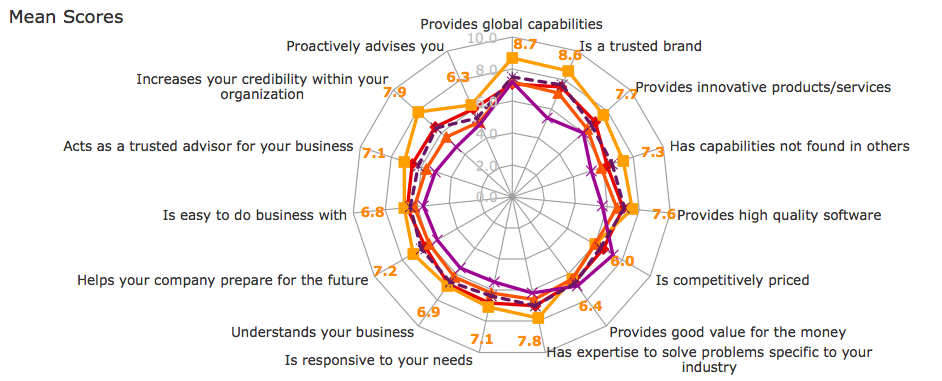
Each color line represents how a competitor scored on performance attributes under capabilities, expertise and strategic advisors. It is almost impossible to distinguish between the five companies represented (except for the competitor in orange, which also happens to have a leading share of market, mind and voice).
What is clear from the research is that rational purchase drivers that communicate business value, although important, are nothing more than “table stakes.” So what creates separation?
The answer: An organization’s ability to build and communicate value based on the understanding of the risk/reward dynamic involved with a purchase decision. The reason: There is a direct correlation between the level of risk and the emotional involvement of the buyer. The higher the risk, the more emotions play a role. Technology purchases are a particularly high risk because they support critical functions within an organization from payroll to customer communications and more.
As a result, personas need to go deeper into understanding the emotional state of buyers as they go through the buying process. Marketers should map the mental state before, during and after the purchase decision, noting the emotions that buyers might be feeling at that time. Here are some key questions to consider as you go through this process:
- What challenge(s) does this purchase decision present for the buyer? It will defer if the buyer is new versus existing. As a marketer, it’s crucial to know how it’s different.
- What personal risks are at stake for this decision maker? Could they lose their job if they make the wrong decision? Invest in understanding their role and their challenges.
- What are the personal rewards for the buyer? Consider how the decision will pay off for them personally. Most often this will be career oriented, but not always.
It’s also important to note that buyers will already have preconceived feelings towards your brand. This may be a benefit or another hurdle to overcome. Our research in partnership with the FORTUNE Knowledge Group found that nearly two thirds of C-level executives said they believe subjective factors that can’t be quantified (including company culture and corporate values) increasingly make a difference when evaluating competing proposals. Only 16 percent disagree. Furthermore, 70 percent believe that a company’s reputation is the most influential factor when deciding what company to do business with.
Buyers trust their gut to make the right decision based on how they feel about a product and/or brand more than we think (and definitely more than we communicate). They make purchase decisions based on emotions, and then justify them with the business value drivers. It’s the emotional connection that triggers the decision and feature/functionality to support it, not the other way around.
What company does this best? It’s Cisco. Research has shown that they are the most emotionally connected customers. Not surprisingly, as Karen Walkers points out, Cisco recognizes that buyers are not just decision makers with budgets, but rather people who are emotional beings.
by scott.gillum | Feb 5, 2015 | 2015, Marketing
Last month (January 6 to be exact,), the Washington, DC area received its first snow of the season. Dropping 3 – 5 inches of snow in the area, it sent school boards scrambling to assess driving conditions and whether to delay opening or closing schools for the day. Most school systems got it right; but one didn’t, and it set off a social media storm that would take over Twitter.
Fairfax County Public Schools (FCPS) in Virginia missed the call and its students (and parents, to some extent) made certain they knew. More snow fell than was forecasted and froze quickly, making the roads and sidewalks treacherous. Close to 30 accidents – including a school bus – were reported during the early morning commute.
Students using the hashtag #closeFCPS expressed their outrage at having to report to class on time in the hazardous conditions. They also became real-time weather reporters by posting videos and photos of snow conditions, roadways and accidents.
 On what was the first day of the Consumer Electronics Show (CES) and the day after the premier of The Bachelor, a bunch of outraged kids in Fairfax County became the top story of the day, trending no. 1 on Twitter nationwide, second worldwide, and received coverage by the Wall Street Journal, Washington Post, BuzzFeed, USA Today, The Huffington Post, as well as making lead story on all the local news channels. And as the day went on, the hashtag took on a life of its own.
On what was the first day of the Consumer Electronics Show (CES) and the day after the premier of The Bachelor, a bunch of outraged kids in Fairfax County became the top story of the day, trending no. 1 on Twitter nationwide, second worldwide, and received coverage by the Wall Street Journal, Washington Post, BuzzFeed, USA Today, The Huffington Post, as well as making lead story on all the local news channels. And as the day went on, the hashtag took on a life of its own.
How’d they do it?
For students who were supposed to be in class, they certainly spent an inordinate amount of time on their smartphones. As a parent of a teenager who attends a school following the snow policy determined by FCPS rulings, I had a first row seat to the social media frenzy. What can their success teach us? Here are five critical components that I observed:
- A common cause – Nothing rallies the Twitter troops more than a common cause. This one was a “no brainer.” A snow day is a rare and precious gift from the snow gods. This was “cause” marketing at its purest.
- A common enemy – The villain of the day was Ryan Mcleveen, a school board member who had developed a strong bond with students through social media (Twitter in particular). Over 41,000 people – many of them students –follow Ryan because he is the first to report school delays and closings…until he didn’t. That’s when the students made him the target of their tweet bombs.
- Short-term objective – Combine a common cause with a short window of opportunity, and you have a heightened sense of urgency to ignite the base and drive the effort.
- Humor – This is what I believe had caused the effort to trend and continue trending well past the decision point for canceling school. The students played a game of one-upmanship with Instagram posts and tweets, with the most humorous being retweeted over and over. As the day progressed, it was the entertainment value rather than the cause that kept the hashtag trending.

- The bandwagon – Once the hashtag trended, teenagers from other school districts, states and even countries jumped in to support the cause and/or to participate in the fun, many having no idea what the hashtag meant.
The Result
Beyond a formal apology from the school board, the students also got their snow day a day later (along with the following two days of delayed starts) while the rest of the school systems in the area were back on a regular schedule. But what they may have gained, more importantly, was influence.
The question is: Were the delays and school closing due to the weather/road conditions, or was it because of the public shaming on Twitter? We may never know, but let’s see what happens on the next snowy day in DC.
Incidentally, that was supposed to be where my story ended. But with snow in the forecast for the following week, I decided to wait to submit this post for obvious reasons. On Tuesday, January 13, the DC area received less than a half an inch of snow. And while other school districts announced a two-hour delay, Fairfax County closed its schools. #FCPSstudents #Winning
by scott.gillum | Jan 12, 2015 | 2015, Marketing
Just in time for the cold and flu season, scientists have recently discovered that the “Pareto principle – the 80/20 rule” applies to infectious diseases. “Super Carriers” who represent 20% of the population, are responsible for transmitting 80% of infectious diseases.
 Superspreaders, like “Typhoid Mary” of the 1900’s, have the ability, although not fully understood, to infect others without falling ill themselves. Come in contact with the one of them, live in a densely populate area, and you’ve got the recipe for a massive outbreak.
Superspreaders, like “Typhoid Mary” of the 1900’s, have the ability, although not fully understood, to infect others without falling ill themselves. Come in contact with the one of them, live in a densely populate area, and you’ve got the recipe for a massive outbreak.
Like viruses, information is spread in similar ways. The importance of “links per node” in social network influence has been studied for years. Research has shown that it’s not the number of links, but rather how “strategically placed” people are in the core of the network, that leads to dissemination of information or disease through a large fraction of the population.
“Typhoid Mary” for example, was a cook in New York City and had an opportunity to infect large groups of patrons with typhoid fever breakfast, lunch and dinner. Readers of The Hot Zone, or Dan Brown’s Inferno, will also be familiar with the concept of geometric progression’s role in the spreading of disease.
Applying these same principals to the distribution of information yields some important insights for content marketers. Given the nuclear arms race going on in content creation and distribution, finding a way to get your message to, and consumed, by targeted audiences is becoming mission critical.
Superspreaders are a perfect route, and represent an opportunity to narrow your message. Think about it this way instead of trying engage 80-100% of your target audience (being everything to everyone) which is a sure fire way to get lost in the noise, you need only to appeal to the right 20%.
How do you find them? It begins with the mind shift of moving from quantity of contacts, to the quality of those contacts…their place in the network. If your organization is set on measuring social media by the number of fans, followers, etc. you’ve got your work cut out.
Find and profile the key influencers in your industry, and/or on a particular subject matter, and don’t solely rely on social media…you’ll end up with “false gods.” Ask the sales force, monitor speakers on industry events, search for authors on the topic, and scan the academic horizon. Once you’ve created your list, study their language.
Now, use your PR and social monitoring tools, as well as other sources, to understand how and what they communicate. Narrow in on those influencers who are in the right position to distribute your content to the right audience, and not those who may have the most followers and/or may be the most active. “Right position” may be related to position to audience, but it may also include, adding validity to your information.
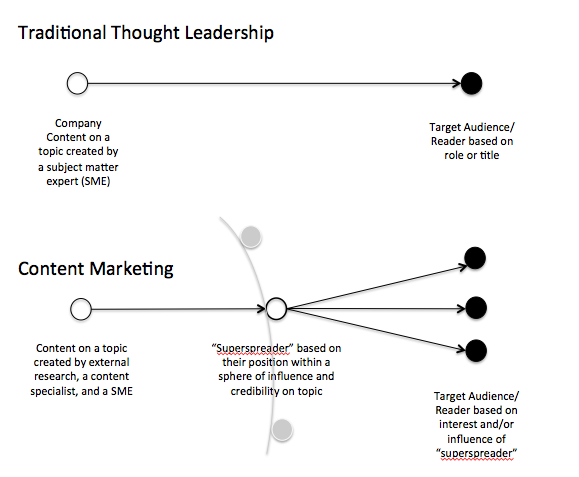
In the digital world, the credibility of the content source is as important, if not more important than, as the actual author/content producer. In the past, companies aimed thought leadership campaigns directly at audience on topics they wanted to communicate. Success with content marketing depends on targeting key influencers with topics that resonate with them in their language so they will pass the information on to their followers.
As a result, you may want to score social spreaders (not a Klout score, use your own ranking) based on their influence (position + credibility). Set a goal for the year to get their attention through a mention or a share, just as you might do with targeted media. Tell your story by designing a content strategy based on the topic areas, language, and the interests of your superspreaders. Then let your “Typhoid Mary or Larry” spread your information…it’s called viral marketing for a reason!
by scott.gillum | Jan 4, 2015 | 2015
It’s the time of the year to look back over the last 12 months and create a “best of” list. This year I’ve pulled the most popular posts from five different sites; Adage, Business2Community, Forbes, Fortune and LinkedIn. In addition, I’ve thrown in a few other noteworthy nuggets from the year at the end of the post.
Adage – Why Apple Pay Could be Huge, And It’s Not What You Think explored the potential upside of Apple Pay as an advertising platform. It sparked the most conversation, and debate, on Twitter. Time will tell if they this strategy will come to fruition.
Business2Community – 5 Key Tips and Da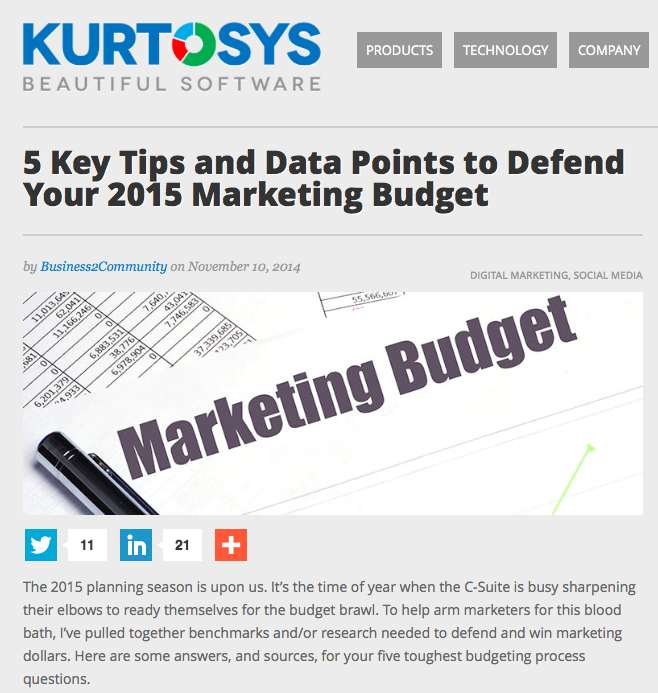 ta Points to Defend You 2015 Marketing Budget. The last post of the year required the most man hours, and it was the most reposted story of the year. It offers marketers help with their 2015 planning activities in the form of free research and benchmark data.
ta Points to Defend You 2015 Marketing Budget. The last post of the year required the most man hours, and it was the most reposted story of the year. It offers marketers help with their 2015 planning activities in the form of free research and benchmark data.
Forbes -the most popular and shared post of the year, Could Falling Test Scores Be a Good Thing for the US? explores the link between test scores and success in business. It also highlights the risk associated with over emphasizing left brain analytic skill development, outlined by Sir Ken Robinson in his Ted Talk video Do Schools Kill Creativity? The endorsement of Marc Andreessen certainly played a big role in the popularity of the post.
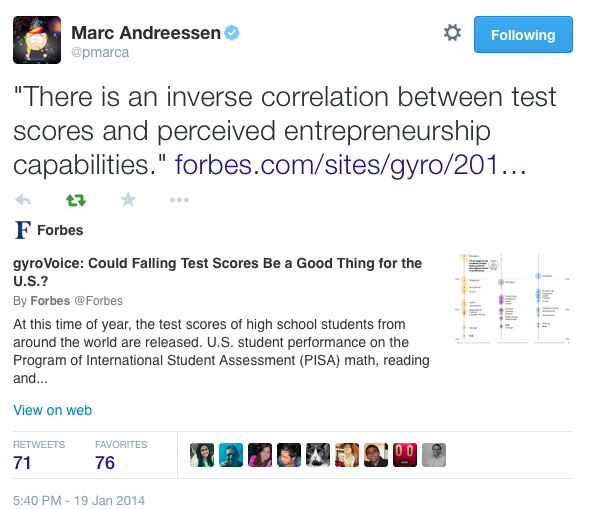
Fortune – Are Marketers Measuring the Right Things was the first post I wrote for our new partnership with Fortune. It profiles the efforts of Ciena, a networking company, to elevate marketings role, and importance, within the organization. The post highlights an unique survey tool used to gather feedback from the sales organization on the performance of marketing (see the dashboard below).
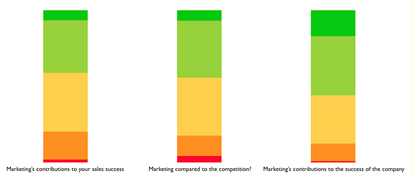
LInkedIn – 2014 marked my first year publishing on LinkedIn. Based on my experience so far, I’m not convince it will viable platform for content unless it becomes better policed. Too much promotional material seems is making its way on to it. At this point, I’m not sure I’ll continue to post.
That said, the most popular post on LinkedIn was also one of the most popular on Adage. The Keys to Differentiating Your Company From Others provides tips on how marketers can humanize their corporate brand to better resonate with audiences. It also identifies one of the common flaws of B2B communication – thinking that what you sell…is who you are. Hopefully, it also helped generated a new client for a follower.

Bonus Stuff
A couple of other noteworthy happenings from the year.
Moving on up.
The Next Generation of Apps Will Be All About You post that ran on Advertising Age was reprinted in the Sept/Oct version of The Portal magazine, a bi-monthly publication produced by the International Association of Movers.
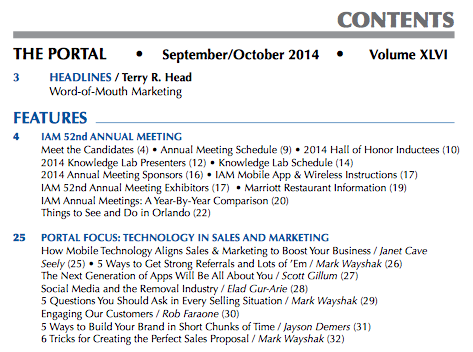 Taking Center Stage
Taking Center Stage
Karen Walker, SVP at Cisco, highlighted my post Everything We Thought We Knew About B2B Marketing is Wrong in her presentation at this year BMA member meeting in Chicago. The post now has close to 70,000 views.
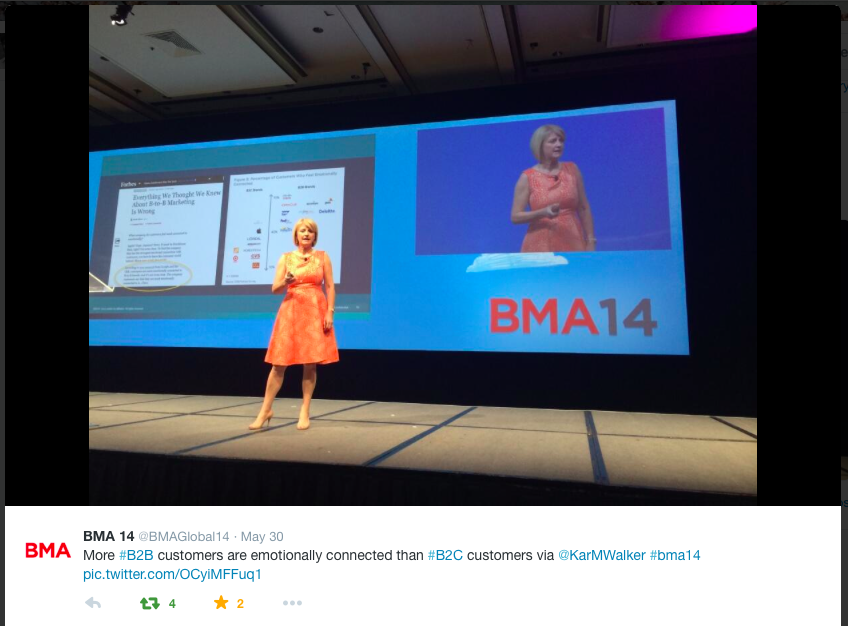
Happy New Year! Here’s to an exciting year to come.



 s culture. One speaker, Bill Rozier from Ciena, provided insight into how to do it effectively. Bill created a lead generation report in an easy to understand PowerPoint slide. As Bill said, “The sales team has to be able to get all the information they need in 30 seconds or less, or we’ve lost them.” Since Bill’s new report launched less than two months ago, lead reconciliation rates have gone from 13 percent to over 70 percent.
s culture. One speaker, Bill Rozier from Ciena, provided insight into how to do it effectively. Bill created a lead generation report in an easy to understand PowerPoint slide. As Bill said, “The sales team has to be able to get all the information they need in 30 seconds or less, or we’ve lost them.” Since Bill’s new report launched less than two months ago, lead reconciliation rates have gone from 13 percent to over 70 percent. ardly varied between brands.
ardly varied between brands.
 On what was the first day of the Consumer Electronics Show (CES) and the day after the premier of The Bachelor, a bunch of outraged kids in Fairfax County became the top story of the day, trending no. 1 on Twitter nationwide, second worldwide, and received coverage by the Wall Street Journal,
On what was the first day of the Consumer Electronics Show (CES) and the day after the premier of The Bachelor, a bunch of outraged kids in Fairfax County became the top story of the day, trending no. 1 on Twitter nationwide, second worldwide, and received coverage by the Wall Street Journal, 


 ta Points to Defend You 2015 Marketing Budget
ta Points to Defend You 2015 Marketing Budget









